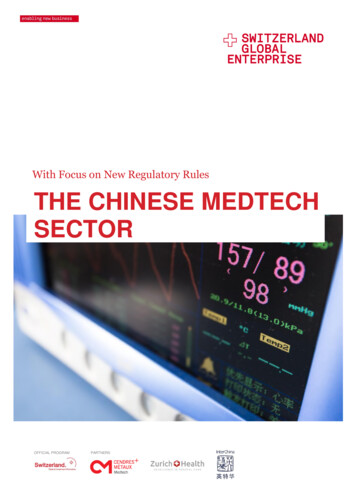
Transcription
With Focus on New Regulatory RulesTHE CHINESE MEDTECHSECTORPlease insert a suitable picture in this sizeOFFICIAL PROGRAMPARTNERS
THE CHINESE MEDTECH SECTORWITH FOCUS ON NEW REGULATORY RULESDate: April 30, 2017Language: EnglishNumber of pages: 31Author: Dr. Urs MattesCo-Authors: Franc Kaiser / Richard Beswick / JensHaarmannOther sectorial Reports: Are you interested in other Reportsfor other sectors and countries? Please find more Reportshere: s-ge.com/reportsDISCLAIMERThe information in this report were gathered and researched from sourcesbelieved to be reliable and are written in good faith. Switzerland GlobalEnterprise and its network partners cannot be held liable for data, which mightnot be complete, accurate or up-to-date; nor for data which are from internetpages/sources on which Switzerland Global Enterprise or its network partnersdo not have any influence. The information in this report does not have a legalor juridical character, unless specifically noted.
Contents1.EXECUTIVE SUMMARY 42.MARKET OVERVIEW 52.1.Government Initiatives 52.1.1.13th Five Year Plan 62.1.2.Healthcare Reform 2020 62.1.3.Made in China 2025 82.1.4.Healthy China 2030 82.2.Chinese Healthcare System 92.2.1.Explosion of Chronic Diseases and Aging 92.2.2.Privatization in Healthcare 92.2.3.Medical Tourism 102.3.Medtech Segments in China 112.3.1.Segment Sizes and Growth Rates 112.3.2.Prices and Tenders 123.IMPORTANT MARKET PLAYERS 133.1.Major International and Domestic Players 133.2.Can Domestic Companies Internationalise? 144.INBOUND AND OUTBOUND M&A 154.1.Inbound M&A 154.2.Domestic-Domestic M&A 164.3.Outbound M&A 175.REGULATORY OVERVIEW 185.1.Order 650 185.2.Fees, Classification and Innovation Channel 185.3.GSP and GMP 196.LOGISTICS AND DISTRIBUTION 216.1.Current System: Inefficient and Fragmented 216.2.Two Invoices System 216.3.Future: State-Run or Private? 227.OPPORTUNITIES AND CHALLENGES FORSWISS SMES 237.1.Why to Enter and Why Not to Enter? 237.2.Challenges of Medtech SMEs in China 257.3.Case Study: Medtech Start-up to China 268.CONCLUSION / CALL-FOR-ACTION 279.ATTACHEMENTS 289.1.Reference 1 289.2.Reference 2 289.3.Reference 3 289.4.Reference 4 289.5.Reference 5 28
1. Executive SummaryEven though 95 per cent of the population is insured by basic medical insurance, the scheme does not address chronically illpatients who need long term treatment. China spends 5.8 per cent of its GDP on healthcare and the per capita expenditure isUS 650, which is inadequate to provide for chronically ill patients. Since there is no gatekeeper in the Chinese healthcaresystem, the government is trying to channel patients to community health centers. The development of the private healthcaremarket is slow, because most doctors do not want to leave careers at public hospitals. Outbound medical tourism has reached asize of US 10 billion in 2015, as affluent people tend to avoid treatment in China. It seems obvious that in the future twodifferent healthcare systems will coexist in China, namely: a large high-volume, low-priced public system and a small lowvolume, high-priced private system. Since the large public system is controlled by the government, tender prices are bound toget lower.In most medtech segments the Chinese market is between 2 and 10 per cent of the global market. Equipment fare better thanimplantable medical devices, the latter being not (or only partially) eligible for reimbursement at present. One would be welladvised not to believe certain consultants and local distributors who claim that the market in China is huge. The potential ishuge but not the market. Most international medtech companies, particularly in the field of implantable medical devices, havea Japanese subsidiary that at present is still larger than their Chinese operation in terms of turnover, despite the much smallerpopulation in Japan compared to China. Nevertheless, the market in China keeps on growing because of urbanisation, theincreasing middle class and an aging population with chronic diseases.One of the major hurdles to enter the Chinese medtech market is the new regulatory rules under Order 650 which requireclinical trials for innovative products. Registering a medtech product in China has become expensive and time-consumingbecause CFDA fees, testing fees and clinical trial fees for an innovative product are high. Clinical studies for an innovativeproduct cost between CNY 7 to 10 million (USD 1 to 1.5 million) and it takes a total of 3 to 5 years to obtain the license. There isan innovation channel, also called «Green Channel», offering fast track review that requires the new products to meet anumber of preconditions in order to qualify. GSP (Good Supply Practice) and GMP (Good Manufacturing Practice) guidelineshave recently been published.For many foreign medtech companies, particularly SMEs, the legal vehicle of a trading company is the preferred way to enterthe Chinese market. Increasingly, however, SMEs look for partnerships with Chinese companies to reduce the risk and tobenefit from the expertise of a local partner. There is no doubt that innovative products are liked by Chinese patients andleading doctors alike. Since the market is crowded with foreign and local companies, it is hard to succeed with «me too»products. As often quoted, it needs time, money and patience to succeed in China. Start-ups might prefer to focus on Europe,USA and Japan rather than China because reimbursed markets are generally preferable and technology in Western markets isprotected.The Chinese medtech market is still dominated by foreign players through imports or their locally manufactured products.Some domestic players, however, have developed well and have become local champions in several medtech segments. Localchampions are often acquisition targets by foreign medtech players which want to get better access to the Chinese market.Mindray and Microport are two good examples of Chinese medtech companies which have successfully internationalised.The «Two Invoices System» is going to reshape the logistics and distribution channels in China and the landscape of themedtech industry. It looks as if «Government appointed suppliers (GAS)» will run the logistics and distribution channels in theChinese healthcare system. The new «Two Invoices System» is an effort under the anti-corruption campaign to develop moretransparent distribution channels.THE CHINESE MEDTECHSECTOR4
2. Market overviewIn this chapter, government initiatives and the Chinese healthcare system are discussed. The currenthealthcare system covers 95 per cent of the population through the basic medical insurance scheme. Thecoverage, however, is not comprehensive and does not address expenditures caused by chronic diseases. Ithappens that patients with chronic diseases cannot pay their health bills and need to file for bankruptcy.Currently, 5 per cent of China’s GDP is spent on healthcare. The healthcare expenditure per capita is US 650(OECD 2013). The Government has ambitious plans to reform the long-neglected healthcare system. A majorinitiative is to let patients enter the healthcare system through community health centers which act asgatekeepers and not through grade 3 hospitals as it is the case at present. Furthermore, private hospitalswhich only account for ten per cent of the patient volume today should double their capacity within the nextfive years. The Government is also allowing doctors from public hospitals to practice at multiple sites in pilotprojects.It is obvious that there will be two healthcare systems in China in the future, namely: 1. a large high-volume,low-priced public and 2. a small low-volume, high-priced private system. Currently, the first system is muchlarger than the second one in terms of medical device sales. In short, foreign medtech players have to learnto adjust to high volumes and low prices while domestic companies have to upgrade their products in orderto compete.Since privatisation is moving forward slowly, a sizeable outbound medical tourism market has developed,increasing 5-fold from the year 2015 to 2016. In the «Healthy China 2030 Reform» the Government tries toimprove the healthcare system so that main health indicators reach the standards of high-income countries,which is a very ambitious target taking the limited resources available into consideration.Undoubtedly, there is a trend to lower prices of medical devices through tenders and to favor locallymanufactured products. As far as locally manufactured products are concerned, there is a distinctionbetween foreign and domestic ownership in some tenders.In most medtech segments, the Chinese market contributes between 2 and 10 per cent of the world market.Claims that the current Chinese medtech market is huge are unfounded, because reimbursement does not oronly partially exist for implantable medical devices. Most typically foreign medtech subsidiaries of MNCs inChina contribute 2 to 10 per cent of global sales and for most MNCs the size of their Japanese subsidiary islarger than the size of their Chinese one.2.1. GOVERNMENT INITIATIVESThe Chinese Government has announced four major plans and reforms. These are: the 13th Five Year plan, the HealthcareReform 2020, Made in China 2025, and Healthy China 2030. Each of these policies address directly or indirectly the reform ofthe healthcare system. Some of these plans and reforms are short to medium-term while others are long-term policies. In thefollowing chapters, the key points of these plans and reforms will be discussed with reference to healthcare.China has seen great progress in the last five years by becoming the second largest economy with per capita GDP increasing toUS 7,800. Undoubtedly, the «new normal» in economic growth is going to be 6 to 7 per cent or even lower. The 6.7 per centreported in 2016 were achieved by substantially increasing the debt burden which is now standing at around 250 per cent ofGDP. Some industries suffer from overcapacities or stagnate, while other industries continue to enjoy healthy growth rates.Generally, healthcare can be regarded as a promising sector for investment in China, even though there are vast differencesbetween segments. Major driving forces are urbanization, increase in chronic diseases and aging of the population.THE CHINESE MEDTECHSECTOR5
2.1.1. 13th Five Year PlanThe 13th Five Year Plan (2016-2020) addresses insurance, healthcare and hospitals, namely: Implementation of supplementary health insurance program for jobless rural and urban residents sufferingfrom major diseasesRetirees who live at places other than their workplaces to have hospitalization fees reimbursed under basichealth insuranceAdvancing reform of public hospitals ending the system to seek profits through over prescription of medicineSet-up personnel and remuneration system appropriate for the healthcare industryThe basic medical insurance system in China which covers approximately 95 per cent of the population cannot be comparedwith Western healthcare systems that cover a wide range of medical treatments. In fact, the coverage is basic, leaving patientsliable for about half of the total healthcare spending, with the proportion rising further for serious and chronic diseases such ascancer and diabetes. It is well known that cardiovascular disorders, cancer and diabetes dominate today’s disease spectrum.Most innovative medical devices and pharmaceutical drugs are not or only partially reimbursed in China. Hence, it happensthat health bills bankrupt families in China, particularly in poor areas and particularly when jobless people are affected, whichis not the case in Europe where the social welfare system covers those in need.The income of Chinese public hospitals consists to a large extent of mark-ups from pharmaceuticals and service fees. Thegovernment tries to introduce a zero markup policy for pharmaceuticals which means that a major income source is vanishingfor hospitals. In order to compensate for the losses from mark-ups of pharmaceuticals, hospital service fees will need to beincreased. There is no doubt that China has opted for a public healthcare system which treats high volumes for a low tomoderate price. In such a system, obviously, the service level will be low to moderate too. The result is a poor and tensepatient-doctor-relationship and wide-spread frustration about the healthcare system in the population. Currently, mostChinese patients have to endure when seeking medical treatment, characterised by long waiting times and short visits withdoctors. It is common that rich Chinese increasingly seek medical treatment abroad which leads to outbound medical tourismwhich is discussed later.Beside public hospitals there are a smaller number of private hospitals. These hospitals have mainly developed in niches suchas gynecology/obstetrics, ophthalmology, dental and some other specialties. Even though doctors would be allowed to treat atseveral sites, administrative barriers are preventing the strengthening of the private sector. Doctors prefer to stay at publichospitals for carrier reasons.Traditionally, Chinese doctors are not well paid at public hospitals and this is still the case today. It is easy for pharmaceuticaland medical device companies to attract young doctors to join them, because the salaries at companies exceed those at publichospitals. Beside the official salary, doctors get commissions from patients, distributors and other sources to improve theirincome. The government and the public know about this and media have covered this topic in China extensively. Therefore, itis vital that the remuneration of healthcare professionals is improved in order to counter this behaviour. There is no doubt thatthe Chinese government is serious about the on-going anti-corruption campaign by piloting the «Two Invoices System» in thepharmaceutical and medical device sectors. The “Two Invoices System” is discussed below.2.1.2. Healthcare Reform 2020There are ten policies in the new healthcare reform (2015-2020) in China. These are: Infrastructure developmento Open investment for private hospitalso Increase the number of hospital bedso Improve and standarize training of healthcare professionalso Improve healthcare services in rural areaso Provide more care facilities for senior citizensTHE CHINESE MEDTECHSECTOR6
Cost reduction and broader insurance coverageo Wider and more comprehensive insurance coverageo Reduce out of pocket expenditures of patients by using locally manufactured medical deviceso Work on doctors’ liability insurance and develop patient-doctor dispute mechanisms New investment segmentso Invest in e-healthcare and cloud systemso Invest in traditional Chinese medicine hospitalsThe government’s target is to increase the number of public hospital beds by 30 per cent and to double the capacity at privatehospitals by 2020. In 2020, there should be 6 hospital beds per 1,000 people in the public and 1.5 per 1,000 people in theprivate sector, respectively. Some of the public hospitals have up to 10,000 beds which make them very customer unfriendlyand difficult to manage. The government tries to reduce the size of some of those large public hospitals. In traditional Chinesemedicine, the plan is to have 0.55 hospital beds per 1,000 residents.There is a substantial shortage of qualified doctors in China in most disciplines. The fields in highest demand are pediatricsand psychiatry. Due to this shortage and the current set-up of the healthcare system which will be discussed below, the patientdoctor relationship is tense. The violence against healthcare providers in China has made headlines and is a tragedy. This is areason why the guidelines foresee a new way to mediate disputes between doctors and patients and try to find compensationmodels for failed cases.It is obvious that the majority of doctors in China have not reached the skill and education level of Western doctors. Chinesepatients are going to grade 3 hospitals to be treated by the most skilled Chinese doctors. This is the reason why most publicgrade 3 hospitals are overcrowded, because patients seek medical treatment from the best doctors. These doctors have littletime left for working with pioneering companies to develop new innovative medical device products. At weekends, thesedoctors often travel to other cities treating complex cases which the local doctors cannot treat.It is now allowed for medical doctors to practice at multiple sites, meaning public doctors have the opportunity to treat atprivate hospitals too. This measure is, however, often ineffective because doctors have internal barriers at public hospitals tolet them practice at non-public hospitals.The guidelines foresee one clinic and one medical service centre for each community with a population of 30,000 and 1.2hospital beds for every 1,000 residents in that community. Focus will primarily be on nursing and rehabilitation. In thecommunities, more emphasis has to be put on senior and home care. These community healthcare centers mirror the functionof general practitioners in the Western system, which act as gatekeepers within the healthcare system.The guidelines envision broader coverage under the basic medical insurance scheme with a stronger emphasis on criticalillnesses to alleviate the financial burden of patients. Undoubtedly, the guidelines aim at reducing the share of importedmedical devices and increasing the share of locally manufactured products. This will negatively affect those foreign medicaldevice companies that import products and are facing competitors which manufacture in China (for example orthopedicproducts). This won’t affect, however, foreign companies with highly innovative products that are not manufactured in China(for example pacemakers). The days of bringing «me too products» into China through imports are over. In some tenders, adistinction between domestic and foreign-owned local manufacturers is made. This implies that when a foreign company buysa Chinese company in order to get easier market access, the local subsidiary may be considered as a foreign entity after theacquisition is made.It is planned to establish three digital national databases containing health information in the form of medical records by2020. Included in these efforts is also the advancement of telemedicine.It is interesting to see that private investments in new healthcare projects are often targeting the affluent Chinese and not themiddle class and rural population. Hence, the role of the government will necessarily be to balance investments.THE CHINESE MEDTECHSECTOR7
2.1.3. Made in China 2025The «Made in China in 2025» initiative is based on Germany’s «Industry 4.0». In a nutshell, «Industry 4.0» aims to create a«smart factory» in which computerized automation lets different parts of the factory communicate with each other in real timevia the Internet of Things and cloud computing while being offered to and used by participants across the value chain.The Chinese effort is challenging, because automation in Chinese companies has in most cases not yet reached the level ofWestern manufacturers and the quality and efficiency of Chinese producers often are still trailing behind their westerncounterparts.Furthermore, the logistics channels in medtech in China are still too underdeveloped and intransparent (e.g. distributorswithout adequate IT systems) to support the progress of «Industry 4.0». Currently, this effort still seems to be driven rather bywishful thinking than practical concepts, because the fundamentals in automated manufacturing and IT-integrated logisticsare not yet established.What looks promising, however, is the fast development of e-commerce in China as the last step in the value chain. China hasleapfrogged the rest of the world in the e-commerce field in a very short time and already has become one of the world leadersin this field.In the «Made in China 2025» plan the healthcare sector is supposed to focus on biological medicine and high-performancemedical devices as one of the priority areas among 9 sectors. So far, no Chinese medical device has made inroads into thedeveloped Western markets (USA, Europe, Japan, Australia and New Zealand). Penetration of those markets is the ultimatetest of whether a medical device is of high calibre or not because these countries account for 80 to 90 per cent of the entiremedtech market.2.1.4. Healthy China 2030The Lancet (Reference 1) article says about «Healthy China 2030»: «Healthcare reform was also acknowledged to beapproaching a very difficult stage with tremendous challenges». Generally, there appears to be a widespread frustration in thepopulation about the current healthcare system. Too little attention has been paid to the healthcare system in the past. Thewake-up call came in 2004 when the SARS epidemic made headlines in China and showed that the country was not preparedto handle this disease.Driven by rapid urbanisation and industrialisation, the major medical challenges China is facing are: Severe environmental pollution (chronic lung diseases, cancer)Diet and lifestyle changes (obesity, diabetes, cancer)Aging society (dementia, osteoarthritis)The second and third challenge are difficult for established Western healthcare systems too, but represent surely more seriouschallenges for a developing country like China with its current healthcare system that has not been tailored to deal with chronicdiseases.Air pollution has reached in certain parts of China hazardous levels which damage the health of people. The hectic lifestyle andadoption of western diets generate overweight, obesity, diabetes, cardiovascular disorders and cancer. It is fair to state that thecurrent healthcare system is not in a position to handle these challenges and reforms are rapidly needed.According to the plan, China will improve the healthcare system so that main health indicators will reach the standards ofhigh-income countries by 2030. Another quote from the Lancet outlines: «.that the ultimate success of China’s ambitioushealth reform depends on well-educated health professionals who have the clinical, ethical and human competencies to matchthe goals for quality and equity in China’s health-care system.»THE CHINESE MEDTECHSECTOR8
2.2. CHINESE HEALTHCARE SYSTEM2.2.1. Explosion of Chronic Diseases and AgingThe fast adoption of Western diets and lifestyle changes has created an explosion of chronic diseases in China such as: 100 million diabetes patients184 million overweight people and 31 million obese patientsCancer as number 1 killer in ChinaIn a recent study published in the Journal of the American Medical Association it was reported that people in China diagnosedwith diabetes mellitus in middle age lost on average nine years of life due to inadequate treatment (Reference 2). The WHOchief, Margaret Chan from Hong Kong said: «The pattern of excess mortality revealed in this study points to significantweaknesses in the clinical management of diabetes, especially in rural areas, and in the effectiveness of population-wideinterventions aimed at prevention».Medtech and pharmaceutical companies which have developed products for diabetes (e.g. Medtronic, Ypsomed), cancer (e.g.Roche, Novartis), and obesity (e.g. Roche) get opportunities to benefit from these developments.Currently, China spends about 5.8 per cent of its GDP on healthcare. The healthcare expenditure per capita based onpurchasing power parity reached US 650 in 2013 in China, which is comparatively low compared to the OECD average of US 3,500. The low level of expenditure is particularly alarming in view of the high costs which chronic diseases such as diabetesand cancer create for patients. It is estimated that the out-of-pocket expenditures reach 50 per cent for those patients.China has 230 million people suffering from cardiovascular diseases. In addition, China accounts for more than 20 per cent ofnewly diagnosed cases of cancer globally each year and more than 25 per cent of global deaths from cancer.The age class of seniors 65 years and older encompassed 90 million people in the year 2000. This group will grow to 176million in 2020 and a staggering 300 million by 2050 which corresponds to the current population of the entire USA. Thiselderly population is prone to be affected by chronic illnesses. Some 80 million elderly, or 60 per cent of all of the country’ssenior citizens, live outside cities and far away from good healthcare facilities. It is estimated that one fifth of rural elderly haveincomes that fall below the official poverty line. In many cases the cost of treating chronic illnesses, which are common amongseniors, plunges the household into debt. It can be said that major changes in healthcare need to occur in order to ensure thatchronic diseases are managed adequately. The current healthcare system cannot successfully tackle this task.2.2.2. Privatization in HealthcareThe current Chinese healthcare system lacks general practitioners which act as gatekeepers in Western healthcare systems.General practitioners in the West treat a large part of patients and refer the few patients they cannot treat. In China, patientsseek treatment at the best grade 3 hospitals and these hospitals are overcrowded with patients. Lower grade hospitals, on theother hand, are under-utilised. This results in long waiting queues, poor service and short visits with doctors. Recently, thegovernment has experimented with community health centers that are intended to act as the first stage in entering thehealthcare system and strived to upgrade grade 2 hospitals. It remains to be seen if patients find this acceptable.There are approximately 23,000 hospitals in China. Based on defined requirements such as size, function, management,quality assurance, and safety, hospitals are classified into grade 3, 2 and 1. Additionally, there are also ungraded hospitals. Inthe public sector, there are 12,200 hospitals (of which 1,550 are grade 3 hospitals) and in the private sector there are 9,800hospitals (of which only 70 are grade 3 hospitals). Even though private hospitals have grown fast, they only account for 10 percent of the patient volume. Most private hospitals have problems attracting high-calibre doctors. When Chinese patients seektreatment, they specifically look for high-calibre doctors and refrain from hospitals which do not feature such luminaries.THE CHINESE MEDTECHSECTOR9
Table 1: Hospital classificationGradeNumberSizeFunctionImported healthcare products31,600 500 bedsRegional hospitals that provide high qualityhealthcare service and perform educational andresearch missionLarge share25,200100-500bedsProvide integrated healthcare service to multiplecommunitiesMedium to low share12,80020-99 bedsProvide healthcare service to local communitiesNo shareForeign health institutions are located in first tier cities such as Shanghai, Beijing and Guangzhou and target the small, butfast-growing, high-income patients which do not rely on the basic medical insurance system. The United Family Group ofhospitals is a chain which has made major inroads as a private hospital. They have several hospitals and clinics in large cities.Increasingly, wealthy Chinese patients seek medical treatment in the neighboring countries and overseas. This topic, namelymedical tourism, will be addressed below.The pilot scheme which has been put in place in some regions of China to allow doctors to practice at multiple hospitals showsthe willingness of the government to strengthen the private sector. Since there is a large middle class of more than 400 millionChinese, this sector should prosper. A lot depends on how these private hospitals can attract high-calibre doctors in order toattract patients.2.2.3. Medical TourismIt is estimated that outbound medical tourism was worth about US 10 billion in 2015. The spending was US 6.3 billion onmedical treatment and US 3.4 billion on travelling.The breakdown of the medical services provided are illustrated below in US : Cosmetic:Wellness:Oncology:Cardiac:Others:1 billion400 million3.5 billion740 million500 millionThere are about 480,000 Chinese seeking wellness and medical treatment abroad annually. South Korea attracts 180,000customers, Taiwan 150,000, Hong Kong 50,000 and other destinations in Asia together about 90,000. Japan attracts Chinesepatients for health checks and cancer treatment with special visas. Overseas medical tourism to Western destinations is stillsmall, with about 10,000 cases. The main destinations are: USA, Germany, Switzerland and UK.Overseas medical treatment is rapidly becoming more popular in China. However, medical treatment in Switzerlandcontributes only a minor part to this. One of the key challenges remains that Chinese still associate Swiss healthcare primarilywith anti-aging treatments. Switzerland's often world-class cancer, cardiology or orthopedic departments are still ratherunknown in China.THE CHINESE MEDTECHSECTOR10
2.3. MEDTECH SEGMENTS IN CHINA2.3.1. Segment Sizes and Growth RatesThe Chinese medtech market accounts for US 25 billion in 2016 (USA is US 170 billion and Japan is US 50 billion). It hasdoubled its size since the year 2008. Overall, the growth rate is above
One of the major hurdles to enter the Chinese medtech market is the new regulatory rules under Order 650 which require clinical trials for innovative products. Registering a medtech product in China has become expensive and time-consuming because CFDA fees, testing fees and clinical trial fees for an innovative product are high.











